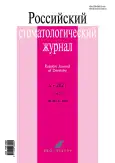Comparative characteristics of the classifications of injuries of the middle zone of the face
- Authors: Grebnev G.A.1, Sviridenko A.D.1, Krasikov A.V.1
-
Affiliations:
- Military Medical Academy S.M. Kirov
- Issue: Vol 25, No 4 (2021)
- Pages: 307-313
- Section: Experimental and Theoretical Investigation
- URL: https://journals.rcsi.science/1728-2802/article/view/109003
- DOI: https://doi.org/10.17816/1728-2802-2021-25-4-307-313
- ID: 109003
Cite item
Abstract
BACKGROUND: Injury of the middle zone of the face is an actual problem of modern maxillofacial surgery. Traumatic injuries of the middle zone of the face in 10% of cases lead to disability of the victims. Fractures of the upper jaw occur in up to 5% of all traumatic injuries of the face. The greatest number of injuries (20–25%) of the middle zone of the face falls on fractures of the zygomatic-orbital complex. Fractures of the orbit are the most common injury of the middle zone of the face, accounting for 40% of all fractures of the facial skeleton. Isolated fractures of one wall of the orbit are recorded in approximately 38–40% of cases, two walls are damaged — in 30–33% of cases, three walls — in 15–20% and all four — in 5–10% of cases.
AIM — to analyze the existing classifications of damage to the middle zones of the face, taking into account clinical manifestations, modern standards and trends in the diagnosis and treatment of injuries of the middle zone of the face, and develop a classification that meets modern ideas about the treatment and rehabilitation of victims with this type of injury.
MATERIAL AND METHODS: The study is based on the results of a study of 335 case histories of patients with injuries of the middle zone of the face aged 17 to 89 years, taking into account concomitant chronic diseases, treated in the clinic of maxillofacial surgery and surgical dentistry of the Military Medical Academy named after S.M. Kirov for the period from 2014 to 2020. Also, the study took into account the results of the analysis of 335 records of radiographic signs, filled in according to the results of radiation methods of research.
RESULTS: An analysis of the classifications of fractures of the middle zone of the face was carried out and a new version of the classification was proposed, which allows the maxillofacial surgeon to assess the volume, depth, extent of damage and draw up an optimal plan. treatment.
CONCLUSION: The developed classification of injuries of the middle zone of the face allows to establish the diagnosis and severity of the general condition of the patient, which is decisive in the course of making a decision regarding the choice of a specialized hospital where the victim will be treated, and also determine the method and timing of surgical treatment.
Full Text
##article.viewOnOriginalSite##About the authors
Gennady A. Grebnev
Military Medical Academy S.M. Kirov
Email: grebnev06@rambler.ru
ORCID iD: 0000-0003-4570-2500
MD, Dr. Sci (Med.), Professor
Russian Federation, Saint PetersburgArtem D. Sviridenko
Military Medical Academy S.M. Kirov
Author for correspondence.
Email: temygreen@gmail.com
ORCID iD: 0000-0002-5547-1892
postgraduate student
Russian Federation, Saint PetersburgAlexei V. Krasikov
Military Medical Academy S.M. Kirov
Email: 301ak@mail.ru
ORCID iD: 0000-0002-4927-7401
Russian Federation, Saint Petersburg
References
- Ippolitov VP, Papin MV. Analiz rezul’tatov lecheniya bol’nykh s posttravmaticheskimi deformatsiyami kraniofatsial’noi oblasti za 20 let. In: Stomatologiya na poroge tret’ego tysyacheletiya: sbornik tezisov. Moscow; 2001. P:360–361. (In Russ).
- Madai DY. Lechenie perelomov nazoetmoidal’nogo kompleksa u postradavshikh s tyazheloi cherepno-mozgovoi travmoi: klinikofunktsional’noe obosnovanie taktiki. Saint Petersburg; 2014. 108 p. (In Russ).
- Medvedev YA. Zygomatic bones anatomy in trauma of lateral part of visceral cranium. The journal of scientific articles health and education millennium. 2012:14(2):22–23. (In Russ).
- Brovkina AF. Rukovodstvo po klinicheskoi oftal’mologii. 2014: 960.
- cr.minzdrav.gov.ru [Internet]. Obshchestvo spetsialistov v oblasti chelyustno-litsevoi khirurgii. Perelom skulovoi kosti [cited 23 Dec 2021]. Available from: https://cr.minzdrav.gov.ru/recomend/633_1
- Le Fort R. Etude experimental sur le fractures de la machoires suoerieuer. Rev chir. 1901;(2,3,4):310–311.
- Gruss JS, Van Wyck L, Phillips JH, Antonyshyn O. The importance of the zygomatic arch in complex midfacial fracture repair and correction of posttraumatic orbitozygomatic deformities. Plast Reconstr Surg. 1990;85(6):878–890. doi: 10.1097/00006534-199006000-00008
- Madai OD. Obosnovanie programmiruemogo mnogoetapnogo khirurgicheskogo lecheniya povrezhdenii srednei zony litsa u postradavshikh s sochetannoi travmoi [dissertation]. Saint Petersburg; 2019. (In Russ).
- Kutsevlyak VI. Anatomic classification of damages facial skeleton. Vіsnik stomatologії. 2010;(4):95–98. (In Russ).
- Shreder G. Ognestrel’nye raneniya chelyustei i ikh lechenie. Petrograd; 1916.
- Duchange R. Les fractures des machoires en pratique. Paris; 1925.
- Wassmund M. Fracturen und Luxationen des Gesichtsschadels. Leipzig; 1927.
Supplementary files







